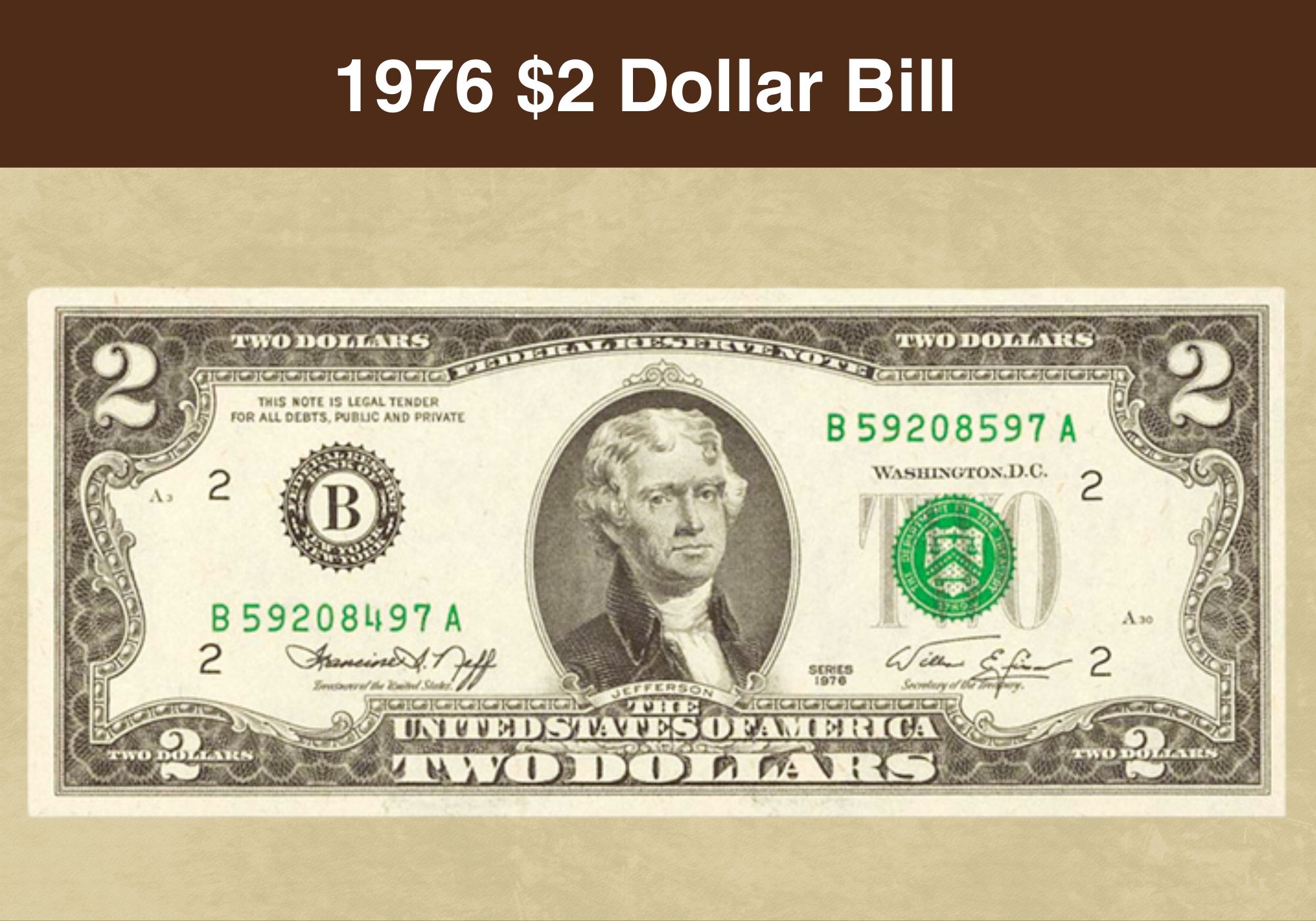
Coin Value Contents Table
The American two-dollar bill is the only commemorative bank note ever printed in United States history. The dollar bill series has a few variations which can create confusion regarding the value of these bank notes.
Keep scrolling to learn more about the 1976 $2 dollar bill value, different errors, history, and much more!
1976 $2 Dollar Bill Value Chart |
| Mint Mark | Circulated condition | Uncirculated condition | Bills with a star |
| 1976 $ 2 with green seal | $5 to $10 | $2 | $8 |
The dollar notes vary in value because of varying serial numbers and particular errors.
1976 $2 Dollar Bill Value
The $2 1976 bills are standard and are not expensive, except for particular notes with unique errors, like a $2 bill with two serial numbers which can sell for hundreds of dollars. The first $2 bill was printed in June 1776, making it the first note to be produced in US history. In 1976, the treasury printed a new $2 banknote series with a green seal.
This banknote was printed to commemorate 200 years of independence. The introduction of these banknotes was also conducted as a cost-saving measure.
The $2 notes were redesigned and printed while giving them the status of a federal reserve note. Most of the portrait and details on the obverse side of the note remained unchanged. In contrast, the serial number and the treasury seal showing the currency’s authenticity are printed in green ink.
Previously, the notes used red ink. A bicentennial design was also used on the reverse side of the banknote. Earlier, a rendition of the Monticello building was used, but this $2 bill replaced the building with a depiction of the Declaration of Independence. The portrait is based on John Trumbull’s painting, where 42 men can be seen on the notes.
The Bureau of engraving and printing (BEP) printed 590,720,000 notes in 1976. While the 1976 $2 bills are common and sell for a bit higher than their face value, the bills stamped on the first date of their release are rare and valuable.
Several federal reserve banks at the time produced these $2 bills, each location with a unique designated number and letter. Boston reserve bank had the number 1 and the letter A and produced the bills from March to October 1976. Similarly, several other reserve banks produced these notes during varying periods. An average of 2 million bills were printed each month.
The black-colored Federal reserve bank seal can be seen to the left of the portrait and contains the bank name and letter. In contrast, the green treasury seal is on the portrait’s right side. Each printed banknote contains one letter and eight digits with details of the printing place and the year of printing.
Some $2 bills had a star instead of the last three digits. These star bills are an error that we will be discussing later. The 1976 $2 bill has two signatures-, one from the Treasury secretary, William Simon, and the other from Treasurer finance, Irving Neff. The paper used to print these bills contains 25% linen and 75% cotton fiber.
The blue and red security fibers are also added to limit counterfeiting. A $2 bill in circulation is worth $2, the same as its face value, but the uncirculated specimens can sell for $10 or higher. The $2 bills with unique serial numbers change in the seal or having an error are pricey and can sell for much more than the face value.
The $2 banknote also garnered a bad reputation, resulting in its poor circulation. The note gains this negative reputation because of several reasons.
For example, at the time, the reward for giving a favorable vote was $2, prostitutes charged $2 for their services, gambling arenas had an average payout prize of $2, and even people believing in numerology saw the number two as a sign of bad luck. The $2 bill remained an unpopular banknote and faced problems with its circulation.
Also read: 12 Most Valuable One-Dollar Coin Worth Money
1976 $2 Bill Grading
Determining the grade of a banknote is crucial if you want to put a value. 1976 dollar bills are graded like coins, each with varying detail levels. We’ve shared a video below that will provide an overview of the 1976 $2 bill and assist you in gathering more information regarding grading 1976 $2 notes.
Also read: 14 Most Valuable Coins In Circulation
Rare 1976 $2 Dollar Bill Errors List
Here’s a list of several 1976 $2 bill errors, misprints, and printing faults that make these notes unique and valuable.
1976 $2 Bill Miscut
Currency notes, including the $2 bill are printed on large sheets of paper and then cut precisely around the edges in a rectangular pattern. However, if the cutting tools are faulty, it can result in this miscut error. The value of the error is mostly between $50 to several hundred dollars.
1976 $2 Dollar Bill Double Serial Number
Sometimes, an issue in the serial number printing device can cause this error. You’ll see two unique serial numbers printed on the same note. These $2 bills were a result of printing errors.
Bills in good condition with two serial numbers will sell from a starting price of $500 or more, whereas those in pristine condition can sell for $900 and upwards. While the errors seen in the $2 bill are mentioned above, several other misprints and unique issues make these $2 bills valuable.
Stamped 1976 $2 Bills
At the time of the note released in August 1976, the first-day collectors were allowed to take their newly received $2 bill and get it stamped from the post office written with the coin’s release date. These stamped $2 bills cost more than the $2 notes already circulating.
The price of a first-day stamped $2 note also varies, depending on its condition, but it doesn’t exceed a hundred dollars. Different stamped $2 indicating different city names also have varying values.
1976 $2 Dollar Bill Star Notes
The $2 bills with a star on the serial number digits is called a replacement note. These currency notes are printed to replace the faulty notes to know precisely the number of printed notes. The star or replacement note is simply a reprint of the error note with a star symbol covering the last three digits.
These star notes can be valuable depending on the reserve bank the notes were printed from. The most valuable star notes were printed in Kansas City and Minneapolis. These reserve banks had the most sought-after serial numbers, making them sell for much more.
While you can find a fine-condition coin worth $8, the $2 bills graded at MS 63 are between $20 to $25. The rare-condition bank notes still preserve the bill’s crisp appearance and the color is worth $80 to $150. Higher-grade notes can even sell for higher prices.
1979 $2 Ladder Bill
The ladder note is the rarest possible two-dollar bill as it has a unique serial number, 12345678. Only one banknote out of every 96 million notes is a ladder note with this serial number, making them one of the rarest finds, which are pricey. These notes are worth thousands of dollars and fetch a very high price at auctions.
The reverse ladder bill is another sought-after serial that starts from eight and ends at one. These bills typically sell for much less than ladder bills. Several other combinations with zeroes in between and notes referred as broken ladders are also valuable but can be found easily.
Factors Determining the 1976 $2 Bill Value
Here are a few key factors that need to be considered when evaluating a bank note’s value.
Condition
Evaluating the note’s condition is the first and most crucial step. If the note dosent have creases, or folds, and is preserved in pristine condition, it will be worth more than a note with evident wear. Likewise, uncirculated bills sell for more than circulated bills.
However, professional note grading services check the notes in detail, keeping in mind the centering, note’s color, margins, brightness, flaws, and ink quality. Typically, a grade from one to seventy is used to grade the bank notes.
Serial Numbers
Most bank note collectors aim to collect bank notes with interesting serial numbers. These combinations can be anything like 11223344, 1101010, or a number of interesting combinations. A double quad serial number has two digits repeated four times like 12121212.
Likewise, a seven-in-a-row serial number refers to having the same number repeat seven times in the serial number e.g. 44444445. Each serial number has varying values and might even sell for thousands of dollars.
Rarity
The rarity of a banknote can increase its value manifolds. The same goes for the 1976 $2 bills. The banknotes released on the day marking the 200th anniversary of America, notes with stamps, and bills having particular serial numbers are rare and more valuable than other varieties.
You can easily find which 1976 $2 bill serial numbers are worth searching and know how much your bills are worth if you have any.
Also read: Top 10 Most Valuable Morgan Silver Dollar Worth Money
1976 $2 Dollar Bill FAQs
What is the value of the 1976 $2 bill today?
The bills printed in the year 1976 to 2003 are only worth their face value, which is $2. However, banknotes with errors, unique serial numbers, and misprints are valued higher. The $2 bills can range from $2 to over $500.
What is the most common error found on the 1976 $2 bill?
The mismatch error is the most common error in the 1976 $2 bill. This occurs when the same note gets overprinted. As the serial number is written on two locations on the note, both serial numbers don’t match.
How to tell if the $2 bill is valuable?
While particular errors, interesting serial numbers, and misprints can make most bank notes valuable, the $2 bills printed before 1976 can be worth a lot more. Evaluating the rarity and the bill’s condition before putting a value is crucial.
Why was the $2 bill so rare in the early 1900s?
The country faced an economic downturn starting from 1929 to 1941, known as the great depression. During that time, most goods, services, and commodities were valued at less than a dollar. The economy was also declining, making the $2 impractical to use in these economically disastrous times. The treasury eventually stopped printing the $2 bills in 1966.
What is the rarest $2 bill?
While most $2 bills before 1976 are worth collecting as they have a historical significance, two $2 uncirculated bills are seen as the ‘Holy Grail’ of the $2 bills. These are US treasury notes dating back to 1890. One note carries a brown seal, whereas the other carries a red one.
What is the most valuable $2 bill in 1976?
The most valuable $2 bills printed in 1976 are the ones with the twice-printed serial number error. Overprinting of the same sheet results in this error. While most mint condition $2 bills can be bought for a few dollars, the bills with this double serial number error range from $400 to $500.
Are $2 bills with red seals rare?
The seal is typically placed on the right side of the note. The last $2 note was printed in 1963 and stopped afterward due to their low demand. The notes printed till 1963 used a red seal instead of several bank notes printed afterward that use a green seal.
How many 1976 $2 bills were printed?
A total of 590,720,000 bills were printed, starting in 1976 and ending in 1978. The bills had two signatures, one from Treasury Secretary Simon and Irving Neff, the Treasurer of finance.
How to check a $2 banknote?
To check your $2 bill, start by inspecting the Federal reserve black seal on the left side. The seal will contain the name and the letter designated to that particular reserve bank. The second step is to inspect the green seal, known as the treasury seal. Besides checking the security features, inspect the portraits on both sides of the bill and lastly match the serial numbers.

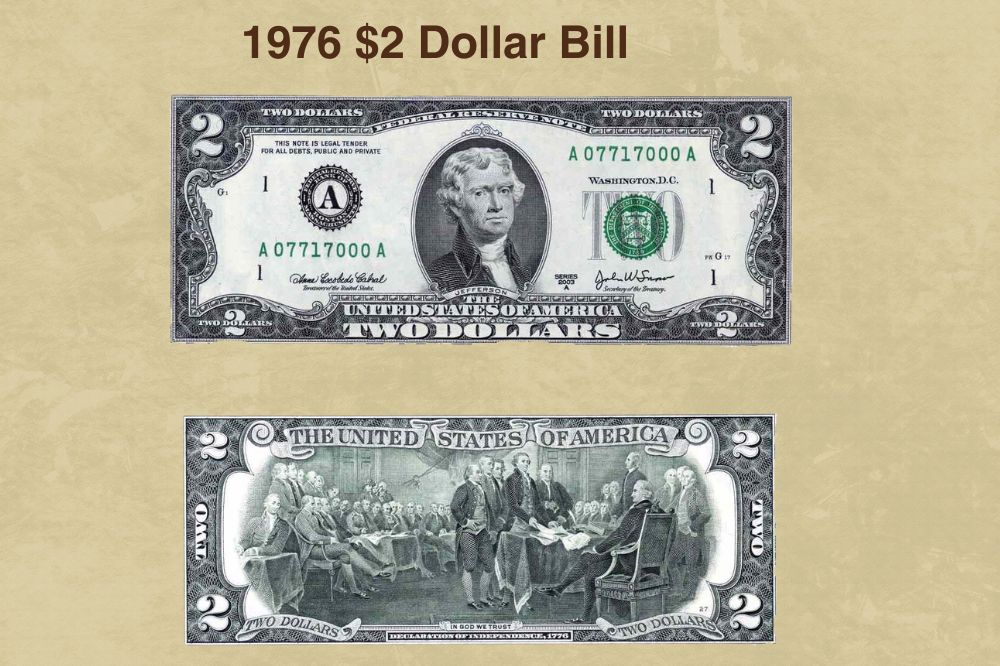
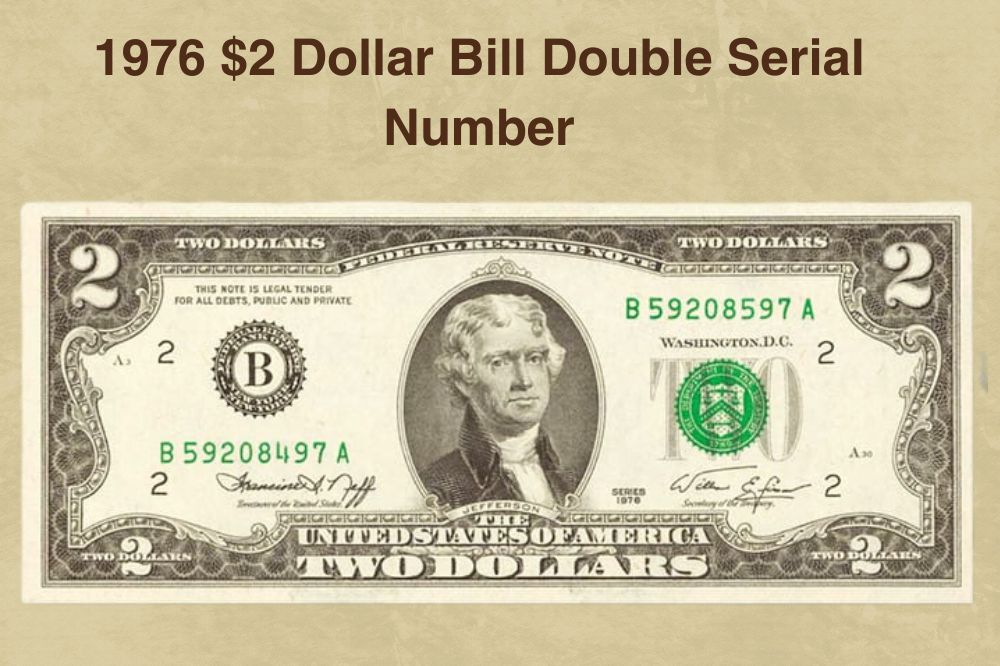
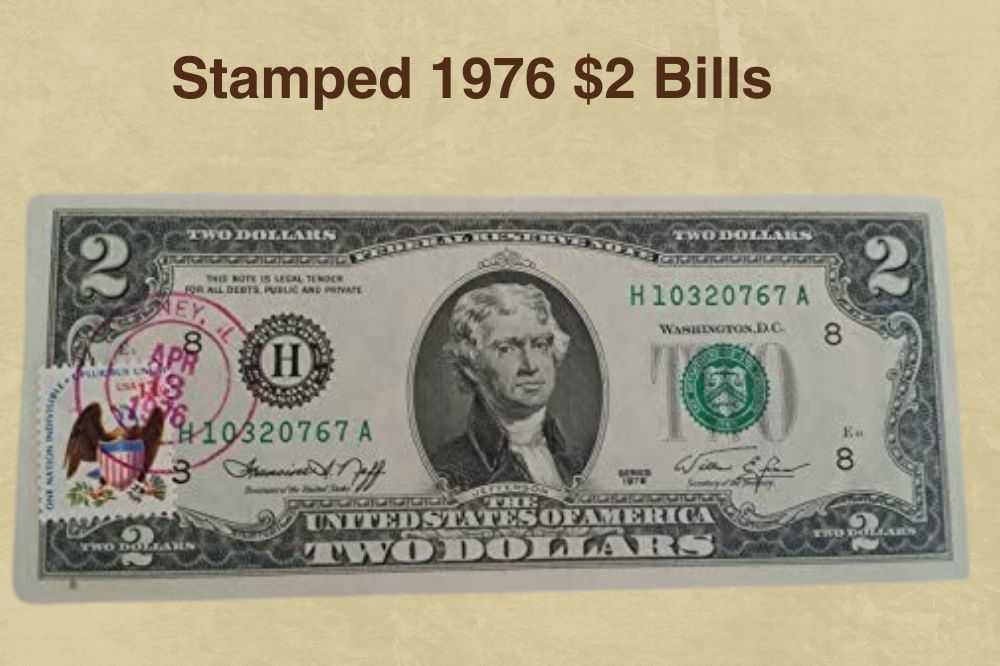
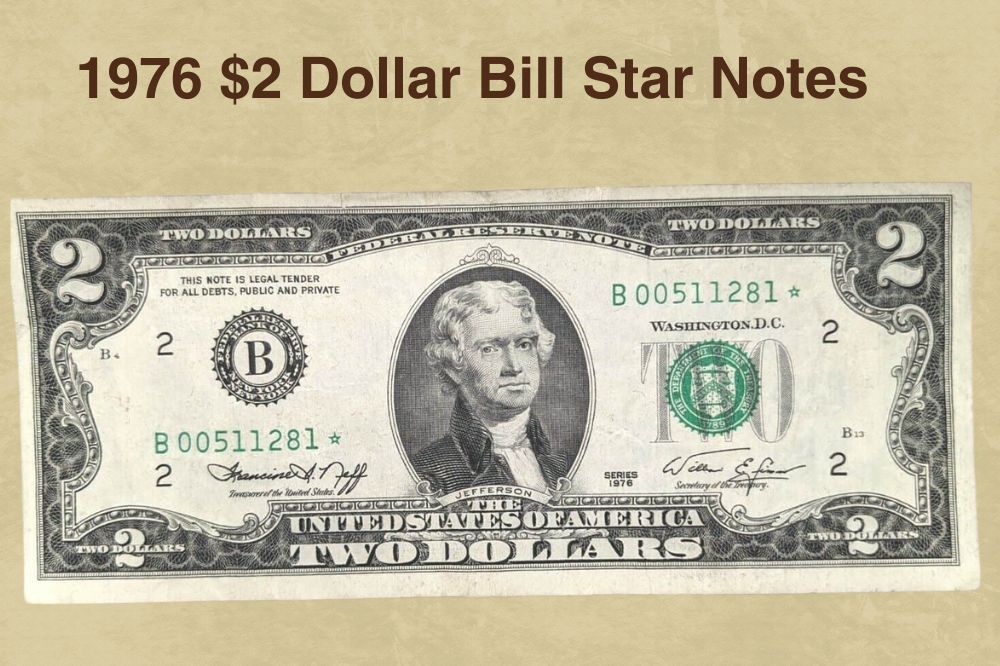
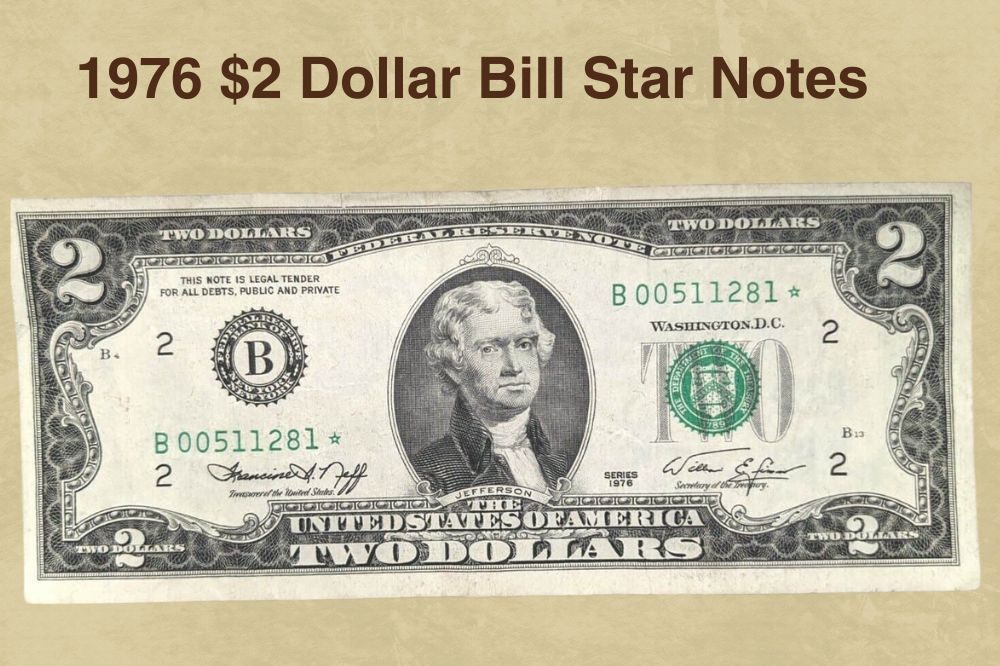
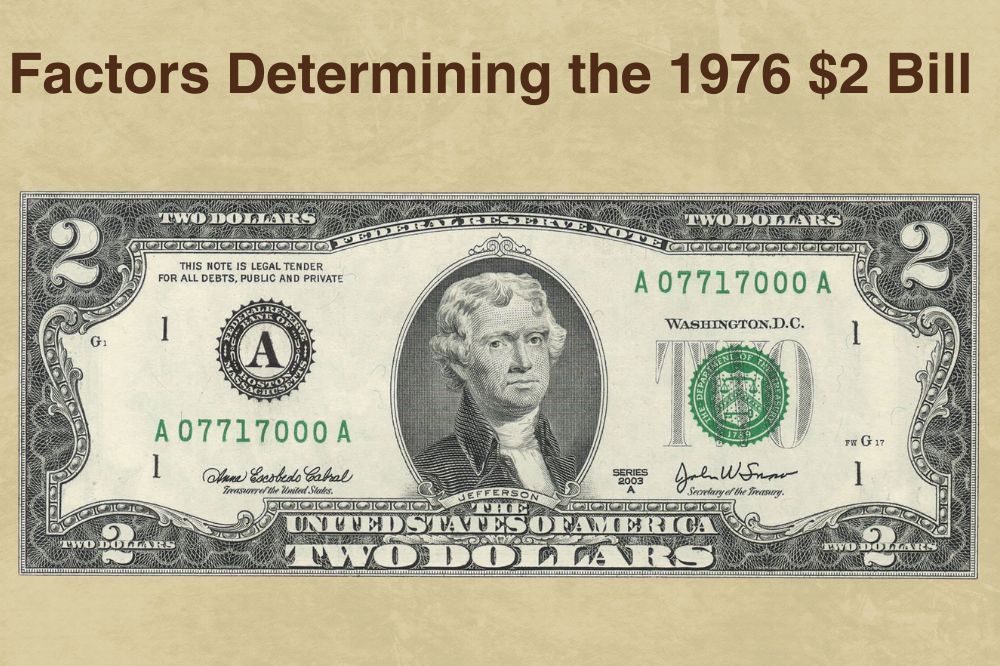
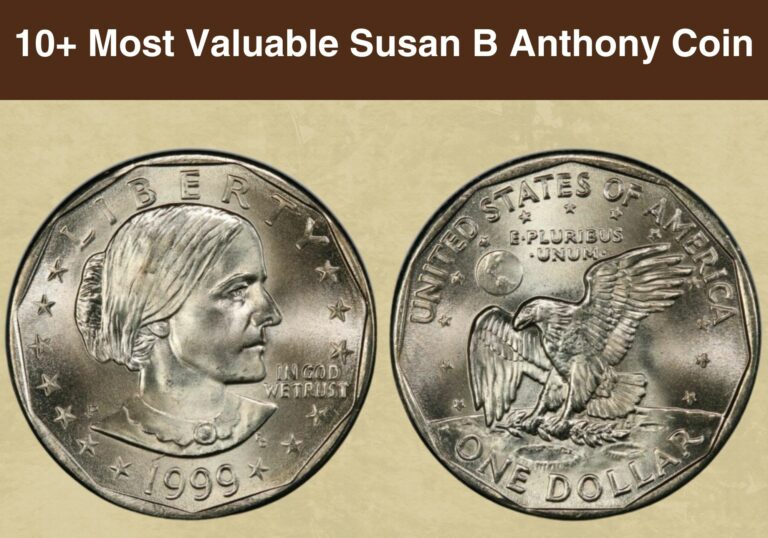
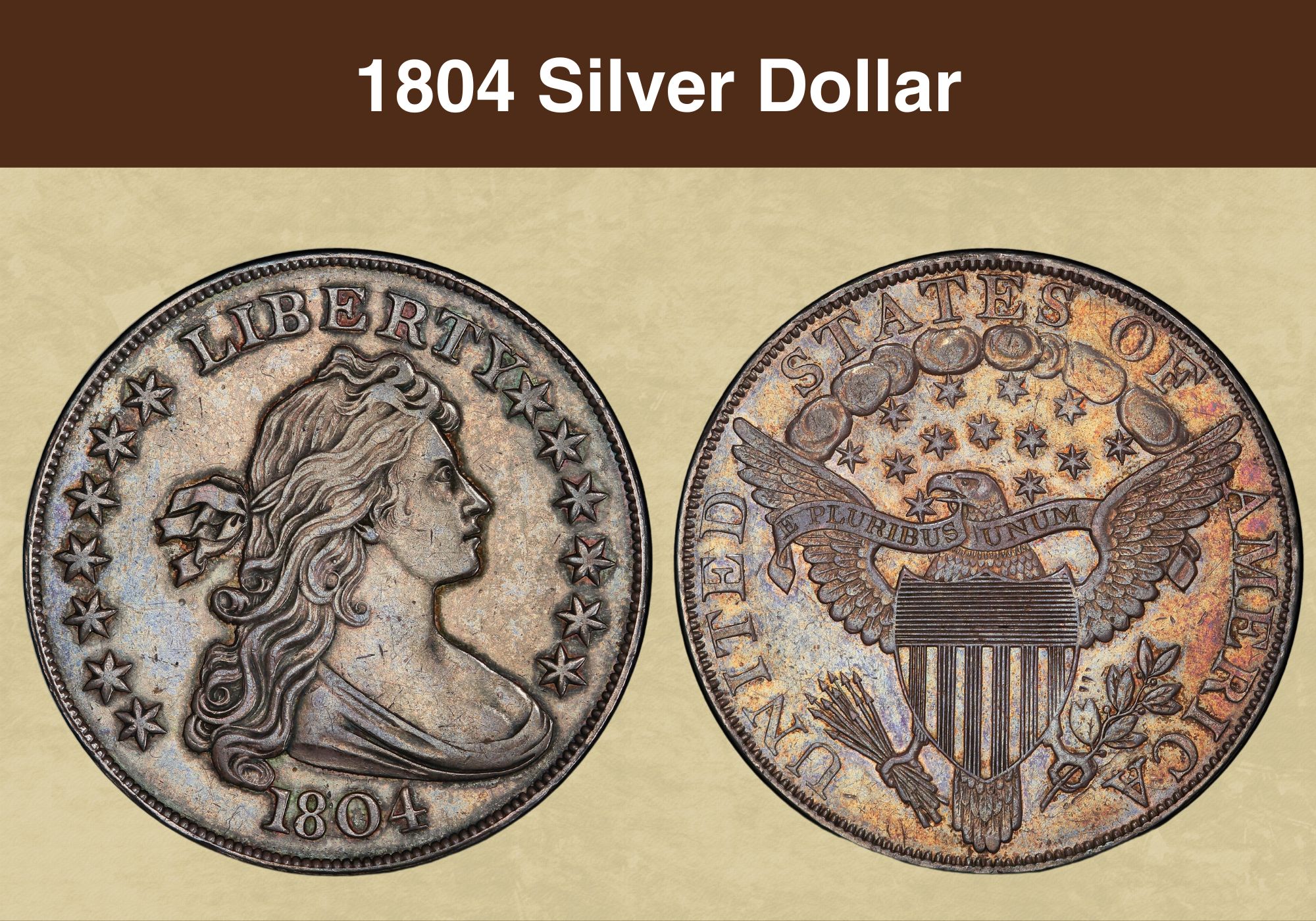
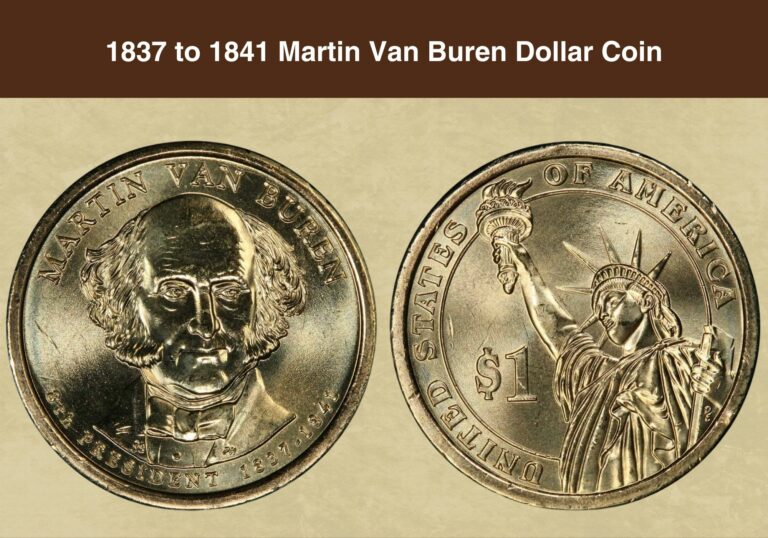
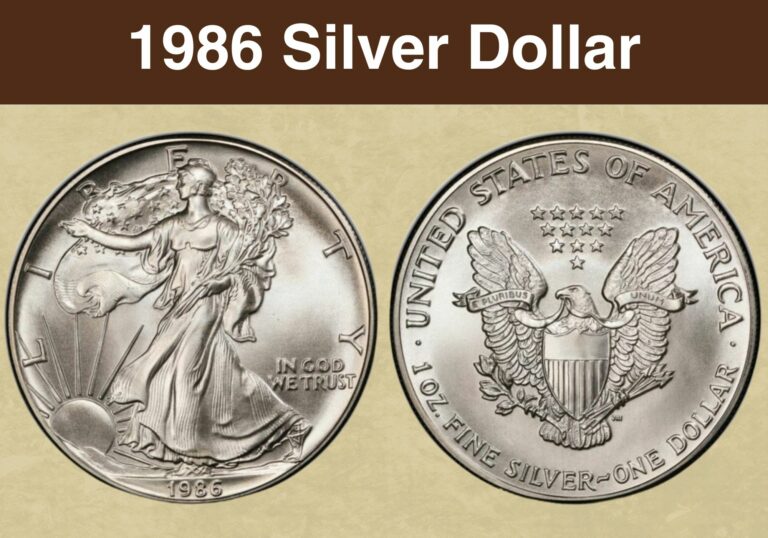
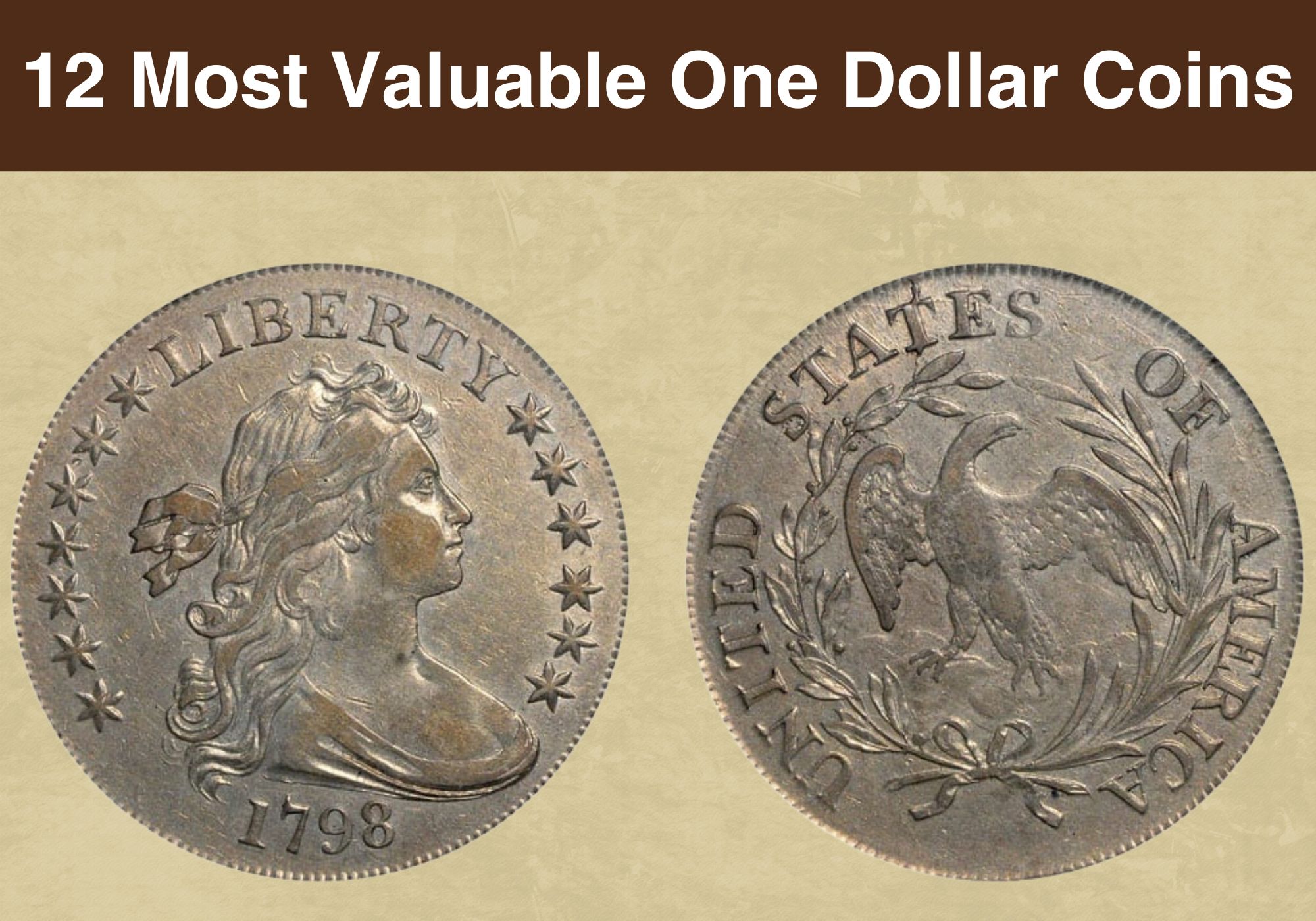
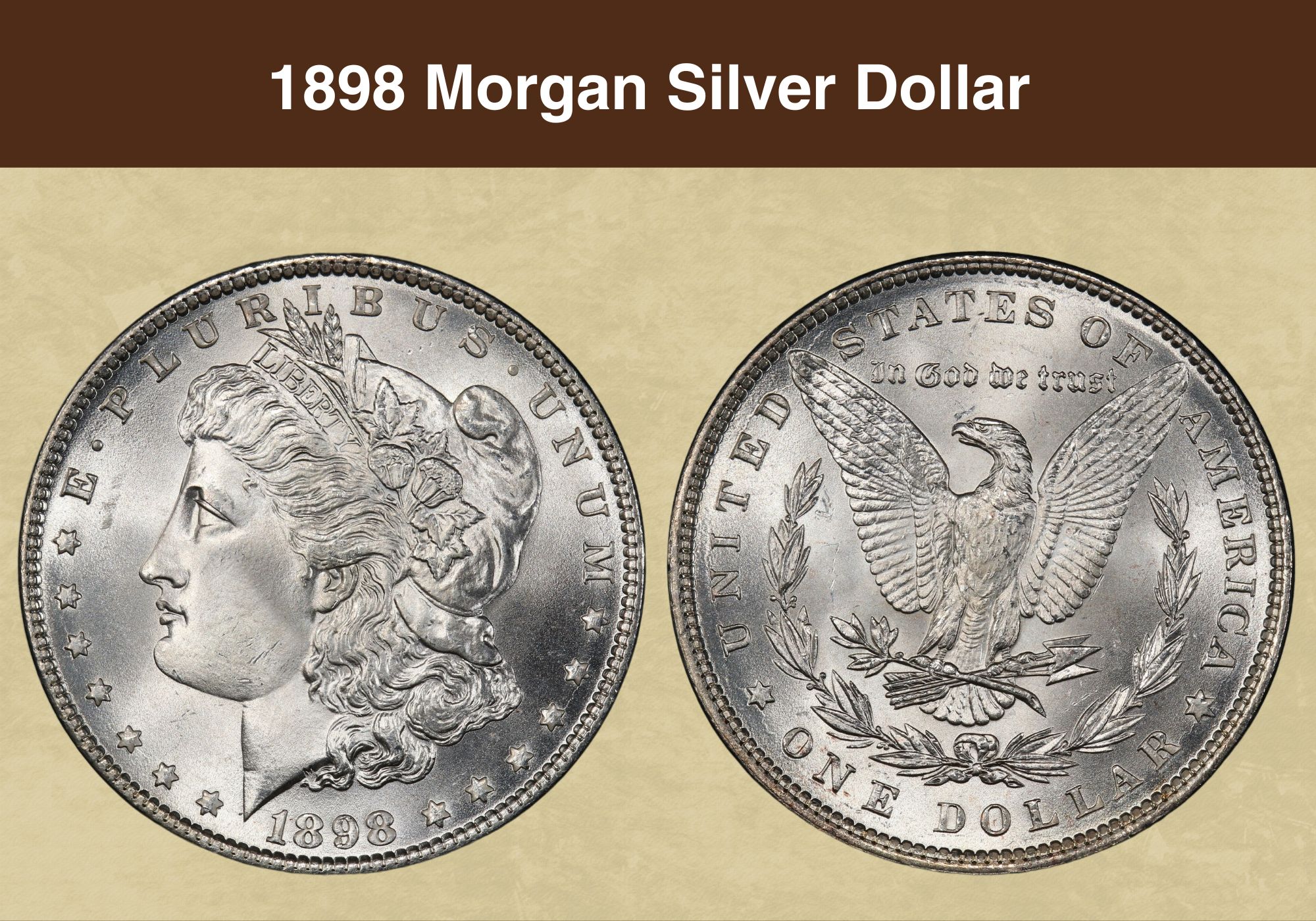
I have a $2 Bill that begins with 07170402 low serial number. In good condition. How can go about getting in graded ? 1976 .year
I have L13254473A-L13254523A All consecutive numbers. not circulated. where is a reputable site?
I have a 1976 with a green seal and St Louis is the bank , serial number is 12734717 is it worth alot ?
Tengo 500 billetescde 2 usd 2017 sin circular consecutivos, tengo 150 billetes de 2 usd sin circular de 1976,100 de ellos consecutivos ,con el sello postal de los 50 estados del 13 de d abril de 1976, 50 de ellos certificados con grados MS64.
Tengo billetes estrellas cerca de 130 de 1,2,5,10,20,100.
Tengo billetes escaleras quebradas, fancy, y radar
I have 3 2 Dollars 1976 with the postage stamp on them Apr 13 1976 from Gibsonton FL. And the serial. number on one of them is F19191591 A and the other one is F 19191595 A in Great condition how much or they worth thanks.
I have 2 $2 bills how can I no what they r worth one has G14672921A
G 14672929 A
I have a $2 bill 1976
G 04987992 A in good condition. Where do I go from here?
O have a 1976 2 dollar bill with S/N starting with 1 is that of value ?
I have a 1976 2 dollar bill with S/N starting with 1 is that of value ?
1976 $2 bill, AU condition, F00591599A = what value?
I have a 1976 $2 bill where the printing of the serial numbers are not in the right place. The one on the right is almost in the border and the one on the left is almost in the picture of Jefferson. What is it worth?